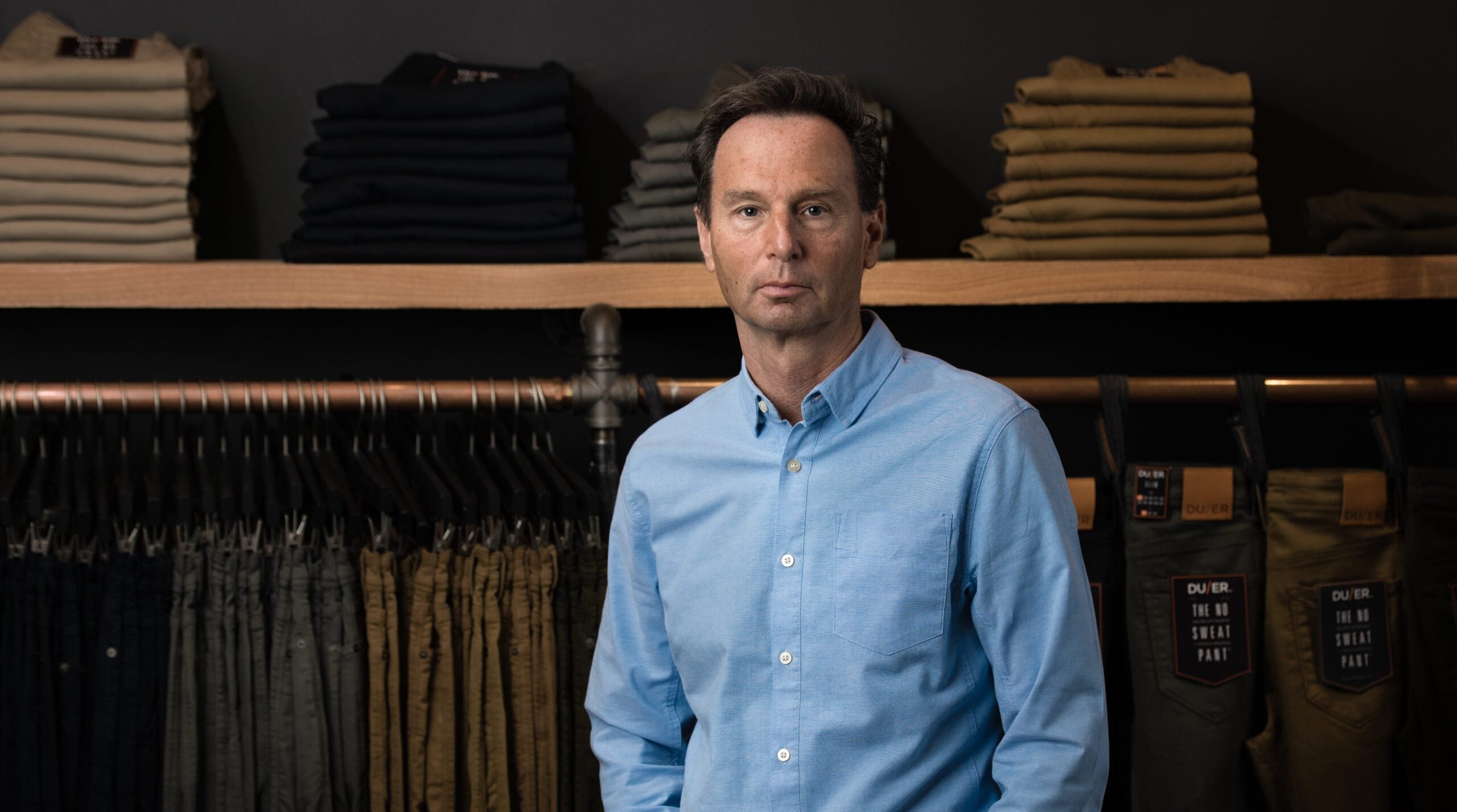Gary Lenett understands the power of consensus. In 2014, when he founded the performance denim company Due, he did it with funds raised through Kickstarter, a proof-first method that relies not on the confidence of big investors or market predictions, but on the voices of real consumers. Enough people wanted Duer jeans, and were willing to pay for them, before Duer jeans even existed.
Now, after six years running Duer the old-fashioned way—scheduling the year around trade shows like Outdoor Retailer, creating products on spec, and selling those products to stores seasons in advance—Lenett has decided to shift to a different model, one similar to how the business got started in the first place. From now on, Duer will embrace crowdsourcing for a number of its future product launches through its Next by Duer program. Consumers will confirm demand before a single item in these lines leaves the factory.
OBJ spoke with Lenett to understand what led to this radical shift, how it works, and why it might just be the direction all brands are headed.
Let’s start with the obvious. This move probably had something, if not everything, to do with the pandemic. Did the coronavirus precipitate this change?
COVID-19 was certainly the impetus. We lost 75 percent of our revenue overnight—literally, from a Friday to a Monday. But I had felt this was the right thing to do for a long time, both from a business and a sustainability perspective. I did four crowdfunding programs through Kickstarter to get Duer off the ground in the first place. That experience taught me just how inefficient the normal way of doing things can be. With crowdsourcing, you’re not creating demand; people are telling you whether the demand is there. That always stuck with me. Over the years, I kept asking my team, “Why can’t we do this as a business model with traditional objectives, not just as a means of starting up?” Change is hard, though. It took a pandemic to force change.
It’s no small task to alter a company’s DNA—the fundamental way it works at all levels. What was the most difficult part of this transition?
A lot of the biggest challenges had to do with supply chain. People will wait for products, but how long will they wait? The traditional lag time in our business is somewhere between eight and 15 months on the wholesale side. Duer is an omni-channel operation—we sell to retailers and directly to consumers—and I know that the consumer is not going to wait 15 months for a product after paying for it. So we had to go to our suppliers and say, “Look, we have to get more agile. We have to get faster.” The thing is, in the last couple of months a lot of our suppliers have had to shift their business models anyway. It really did take this crisis to get them on board. Of course, it helped that two of my suppliers are partners of mine. One was a cofounder of Duer who has a factory in Pakistan and the other was an initial investor in Duer with a factory in China.
How does faster production work? What does it look like from a factory perspective?
Well, look at Zara, for example. To be clear, I consider “fast fashion” the devil. I think it does incredible damage and I wish it had never happened. But it’s based on a quick-response production model. Zara figured out that they could make money doing small drops quickly and chasing the products that sell. That led to some terrible things, including 67 pounds of clothing going into landfills in North America, per person, every single year. But it proved that quick-response production can work. What we’re doing is tapping into the same technology without creating spec inventory. It’s called modular manufacturing and it takes different equipment, different skills, but it does exist. People aren’t sitting at sewing machines, they’re at stand-up machines, they work in groups of eight to ten people and they’re all cross-trained. It’s not as though everybody is doing one discrete task, like on a typical production line. Workers swarm where there’s a bottleneck, moving around all the time. I really think this is going to be the next way of doing business. It’s just logical.
So you’ve convinced your suppliers to switch to this new model, but what about your retailers? How do they feel about it?
They’re completely on board. Think about it this way. What’s the largest cost we have in our industry? When you look up and down the supply chain, it’s the fact that brands are doing speculative inventory, and they don’t know for sure, nor do their retailers know, how well anything is going to sell. When something doesn’t sell, that loss moves down the chain and affects everyone. It’s why some companies might start at a 50- or 60-point margin on a product but only take 35 or 40 percent at the end of the day, because the product didn’t move like they thought it would. Retailers obviously feel that pain too. Any way of doing business that eliminates that waste and unpredictability is going to help retailers.
But doesn’t it stand to reason that if you condition customers to buy from your brand directly through crowdsource campaigns, they’ll have less reason to buy from retailers?
Going back 15 years, the tension around selling directly to customers was a big issue. I personally think there’s only one way to build a brand these days, and that’s omni-channel. My retail partners understand that. The more we can get consumers “pulling” the brand through brand awareness—which direct-to-consumer sales help with—the less our retailers are going to have to be pushing our products in store to get them to sell. What we’re trying to do here is make sure our products represent a retailer’s highest margin line. If we can make sure there’s market acceptance of a product before anyone takes speculative inventory, everybody wins.
Will retailers be forced to wait to stock your products until after consumers have vetted them?
Not at all. We’re also rolling out a B2B site where retailers can order products immediately at wholesale pricing if they don’t want to wait for our direct-to-consumer campaigns to prove a product’s viability. So for instance, if we do a three-week crowdsourced pre-sale for a new product, hit our minimums, go into production, and deliver within four to eight weeks, retailers will have the same option to buy that product on our B2B site and put it in their stores just as quickly. Or they can wait until we get feedback from consumers to decide if they want to stock that product or not.
What kind of feedback have you gotten from around the industry about this new model?
I know a lot of retailers and I’ve been using them as informal consultants to develop these plans all along. I haven’t been doing it in a vacuum. Truthfully, I haven’t had any negative responses to this. We’ve just gone through this trauma where retailers ordered goods months and months ago, received them, and then had to close down for nine or ten weeks. Now brands are coming in and trying to sell them more products? It’s ridiculous. None of these retailers know what they’re going to do with their existing inventory, and brands are already asking them to commit to more. This quick-response model just makes sense. I just can’t see any negatives to it. And it’s taken a pandemic—a nightmare, really—for others to see that too.


